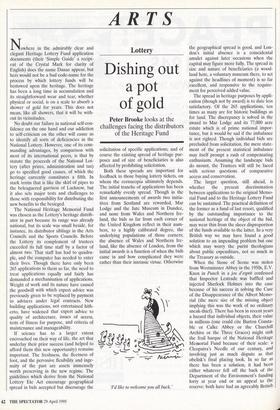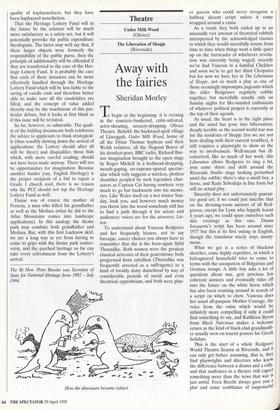ARTS
Lottery
Dishing out a pot of gold
Peter Brooke looks at the challenges facing the distributors of the Heritage Fund Nowhere in the admirably clear and elegant Heritage Lottery Fund application documents (their 'Simple Guide' a recipi- ent of the Crystal Mark for clarity of English) does the name Danae appear, but hers would not be a bad code-name for the process by which lottery funds will be bestowed upon the heritage. The heritage has been a long time in accumulation and its straightforward wear and tear, whether physical or social, is on a scale to absorb a shower of gold for years. This does not mean, like all showers, that it will be with- out its vicissitudes.
No doubt our failure in national self-con- fidence on the one hand and our addiction to self-criticism on the other will cause us to identify all sorts of deficiencies in the National Lottery. However, one of its com- manding advantages, by comparison with most of its international peers, is that by statute the proceeds of the National Lot- tery (after prizes, administration and tax) go to specified good causes, of which the heritage currently constitutes a fifth. In stark terms that is like the skirl of pipes to the beleaguered garrison of Lucknow, but it also sets major tests and challenges to those with responsibility for distributing the new benefits to the besieged.
The National Heritage Memorial Fund was chosen as the Lottery's heritage distrib- utor in part because its range was already national, but its scale was small beside, for instance, its distributor siblings in the Arts Councils and the Sports Councils. Before the Lottery its complement of trustees exceeded its full time staff by a factor of almost two. That staff has had to quadru- ple, and the computer has needed to enter their lives. Though there have only been 265 applications to them so far, the need to treat applications equally and fairly has demanded a mechanisation of applications. Weight of work and its nature have caused the goodwill with which expert advice was previously given to be replaced by payment to advisers under legal contracts. New building applications; not entertained hith- erto, have widened that expert advice to quality of architecture, issues of access, tests of fitness for purpose, and criteria of maintenance and manageability.
If science has to a larger extent encroached on their way of life, the art that underlay their prior success (and helped to afford them this new opportunity) remains important. The freshness, the fleetness of foot, and the pervasive flexibility and inge- nuity of the past are assets immensely worth preserving in the new regime. The guidelines which derive from the National Lottery Etc Act encourage geographical spread in bids accepted but discourage the solicitation of specific applications; and of course the existing spread of heritage pur- poses and of size of beneficiaries is also affected by prohibiting solicitation.
Both these spreads are important for feedback to those buying lottery tickets, on whom the cornucopia ultimately depends. The initial tranche of applications has been remarkably evenly spread. Though in the first announcements of awards two initia- tives from Scotland are rewarded, Mar Lodge and the Jute Museum in Dundee, and none from Wales and Northern Ire- land, the bids so far from each corner of the United Kingdom reflect in their num- bers, to a highly calibrated degree, the underlying populations of those corners; the absence of Wales and Northern Ire- land, like the absence of London, from the initial awards is a function of when the bids came in and how complicated they were rather than their intrinsic virtue. Otherwise `I'd like to welcome you all back' the geographical spread is good, and Lon- don's initial absence is a coincidental amulet against later occasions when the capital may figure more fully. The spread in size and nature of beneficiaries (a wood- land here, a voluntary museum there, to set against the headlines of moment) is so far excellent, and responsive to the require- ment for perceived added value.
The spread in heritage purposes by appli- cation (though not by award) is to date less satisfactory. Of the 265 applications, ten times as many are for historic buildings as for land. The discrepancy is solved in the award to Mar Lodge and its 77,000 acre estate which is of prime national impor- tance, but it would be sad if the imbalance is not righted. Though individual bids are precluded from solicitation, the mere state- ment of the present statistical imbalance may itself prompt a rush of compensating enthusiasm. Assuming the landscape bids do mount, the Trustees will still be faced with serious questions of comparative access and conservation.
The larger question, still ahead, is whether the present discrimination between applications to the original Memo- rial Fund and to the Heritage Lottery Fund can be sustained. The practical definition of the former as a fund of last resort, qualified by the outstanding importance to the national heritage of the object of the bid, may wear thin from the sheer disproportion of the funds available to the latter. In a very British way we may have found a good solution to an impending problem but one which may worry the purist theologians about public expenditure, not so much in the Treasury as outside.
When the Stone of Scone was stolen from Westminster Abbey in the 1950s, E.V. Knox in Punch in a jeu d'esprit confessed that Inspector Lestrade was baffled and injected Sherlock Holmes into the case because of his success in solving the Case of the Disappearance of the Albert Memo- rial (the mere size of the missing object implying this was the work of no ordinary sneak-thief). There has been in recent years a hazard that individual objects, their value in millions (one could cite Burton Consta- ble or Calke Abbey or the Churchill Archive or the Three Graces) might sink the frail barque of the National Heritage Memorial Fund because of their scale: a Cleopatra's Needle of our century, and involving just as much dispute as that obelisk's final placing took. In so far as there has been a solution, it had been either whatever fell off the back of the Department of the Environment's funding lorry at year end or an appeal to the reserve: both have had an agreeably British
quality of haphazardness, but they have been haphazard nonetheless.
That the Heritage Lottery Fund will in the future be the solution will be much more satisfactory as a safety net, but it will potentially provoke the public expenditure theologians. The latter may well say that, if these larger objects were formerly the responsibility of the public purse, then the principle of additionality will be offended if they are transferred to the care of the Her- itage Lottery Fund. It is probably the case that each of these instances can be more effectively handled through the Heritage Lottery Fund which will be less liable to the saving of candle ends and therefore better able to make sure all the candelabra are filled, and the concept of value added thereby may be the touchstone of this par- ticular debate, but it looks at first blush as if this issue will be revisited.
So far, however, so admirable. The quali- ty of the bidding documents both reinforces the advice to applicants to think strategical- ly (thus sensibly slowing down the arrival of applications: the Lottery should after all still be there) and disqualifies those bids which, with more careful reading, should not have been made anyway. There will too be opportunities for imagination. Because another funder (say, English Heritage) is the proper recipient of a bid to repair a Grade 1 church roof, there is no reason why the PCC should not tap the Heritage Lottery Fund as well.
Danae was of course the mother of Perseus, a man who killed his grandfather as well as the Medusa (what he did to the Atlas Mountains comes into landscape applications). In this analogy the theme park may combine both grandfather and Medusa. But, with this first Lucknow skirl, we are a long way as yet from having to come to grips with the theme park contro- versy, and the parched heritage so far can take every refreshment from the Lottery's arrival.
The Rt Hon. Peter Brooke was Secretary of State for National Heritage from 1992 — July 1994.
How the dinosaurs became extinct.



























































 Previous page
Previous page